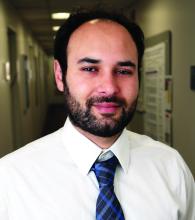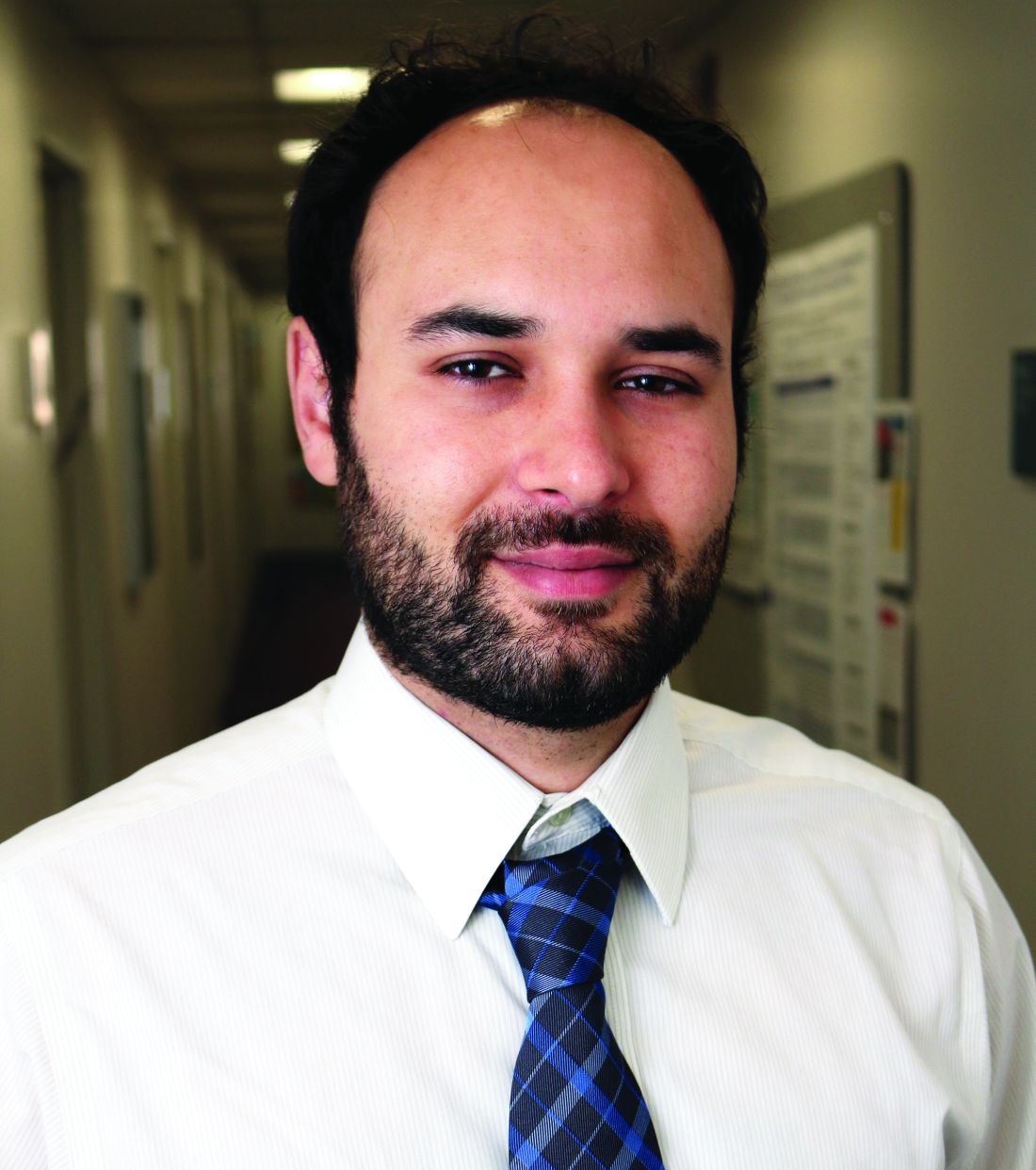User login
, a small randomized controlled trial found.
The results suggested that any effects of TRE on weight observed in prior studies may be due to reductions in caloric intake and not timing, according to Nisa M. Maruthur, MD, MHS, of the Division of General Internal Medicine at the Johns Hopkins School of Medicine in Baltimore, and colleagues.
Published in Annals of Internal Medicine, the 12-week trial randomly assigned 41 adults aged 18-69 years with obesity and prediabetes or diet-controlled diabetes 1:1 as follows: To TRE, involving a 10-hour eating window with 80% of calories consumed before 1 PM, or to UEP, involving a ≤ 16-hour window, with at least 50% of calories consumed after 5 PM. The regimen in each group was based on the OmniHeart unsaturated fat diet and the SPICE study.
“The diet was similar to the DASH [Dietary Approaches to Stop Hypertension] diet for hypertension and maybe a bit higher in unsaturated fat and micronutrients,” said study co-author Scott J. Pilla, MD, MHS, an assistant professor of medicine at the Johns Hopkins Bloomberg School of Public Health, Baltimore, in an interview. For each participant, macro- and micronutrient content remained constant throughout the study period, with total calories individually determined at baseline and ranging from 1600 to 3500 kcal/d. “That differs from some TRE studies in which calories were adjusted according to whether participants lost or gained weight,” he said. “This was a purely mechanistic study to determine the impact of time of eating alone with no change in calories.”
Although the current findings revealed no weight loss advantage, some evidence suggests that limiting the food consumption window to 4-10 hours naturally reduces energy intake by approximately 200-550 calories per day and can result in a loss of 3%-5% of baseline body weight for 2-12 months. In addition, TRE has been shown to improve metabolic risk factors, such as insulin resistance, blood pressure, and triglyceride concentrations — but not in this study.
The Cohort
The mean age was 59 years, 93% of patients were women, and 93% were Black. The mean body mass index was 36, and the mean baseline weight was 96.2 kg — 95.6 kg in the TRE group and 103.7 kg in the UEP group.
At 12 weeks, weight decreased comparably by 2.3 kg (95% CI, 1.0-3.5) in the TRE group and by 2.6 kg (95% CI, 1.5-3.7) in the UEP group. Change in glycemic measures did not differ between the two groups.
Interestingly, self-reporting questionnaires revealed a slight reduction in physical activity in the TRE group, an effect that requires further study. “We don’t know why but anecdotally, some TRE participants said they tended to go to bed earlier,” Dr. Pilla said. Earlier bedtimes may put an end sooner to the daily eating pattern.
Subanalyses of the data are ongoing and will be published later.
“In the context of several clinical trials that suggest a benefit of TRE, our findings suggest that if or when TRE interventions induce weight loss, it is likely in part due to a reduction in energy intake, and therefore, clinicians can counsel patients that TRE may help them lose weight by decreasing their caloric intake,” the authors wrote.
In an accompanying editorial, Krista A. Varady, PhD, and Vanessa M. Oddo, PhD, of the Department of Kinesiology and Nutrition at the University of Illinois–Chicago, said the study results have important clinical implications. “Many patients stop following standard-care diets (such as daily calorie restriction) because they become frustrated with having to monitor food intake vigilantly each day,” they wrote.
Although TRE is no more effective than other diet interventions for weight reduction, it offers a simplified approach to treat obesity by omitting the need for calorie counting. “TRE bypasses this requirement simply by allowing participants to ‘watch the clock’ instead of monitoring calories, while still producing weight loss,” they wrote.
The straightforward nature of this diet makes it well suited for remote delivery, which can reduce the scheduling and financial barriers associated with inpatient visits, they added. “Moreover, TRE does not require the purchase of expensive food products and allows a person to continue consuming familiar foods, making it a high accessible diet for lower-resource populations.”
Gastroenterologists and Obesity
Of late, support has grown for gastroenterologists to become actively involved in obesity treatment — even to “take ownership” of this field.
In a 2023 article in Gut, Michael Camilleri, MD, AGAF, a gastroenterologist at the Mayo Clinic in Rochester, Minnesota, made the case for the natural fit between gastrointestinal (GI) specialists and obesity management. He noted that obesity is a significant risk factor for GI, pancreatic, and liver diseases. It can even affect inflammatory bowel disease.
“Treating obesity starting when patients present in gastroenterology and hepatology clinics has potential to impact serious consequences of obesity such as cardiovascular risks,” he wrote.
Gastroenterologists already treat GI conditions with pharmacologic and surgical interventions that can also be used to treat obesity and improve glycemic control. These include pancreatic lipase inhibitors and incretin, bariatric endoscopy and surgery, and combination therapies targeting metabolic problems.
This study was supported by the American Heart Association.
Dr. Maruthur reported receiving royalties from a virtual diabetes prevention program. Dr. Pilla reported receiving travel, advisory, and speaker fees from the American Diabetes Association. Numerous authors reported receiving grants from government and nonprofit research funding organizations. Dr. Varady disclosed having no competing interests. Dr. Odda reported receiving research support and honoraria from government nonprofit funding organizations.
A version of this article first appeared on Medscape.com.
, a small randomized controlled trial found.
The results suggested that any effects of TRE on weight observed in prior studies may be due to reductions in caloric intake and not timing, according to Nisa M. Maruthur, MD, MHS, of the Division of General Internal Medicine at the Johns Hopkins School of Medicine in Baltimore, and colleagues.
Published in Annals of Internal Medicine, the 12-week trial randomly assigned 41 adults aged 18-69 years with obesity and prediabetes or diet-controlled diabetes 1:1 as follows: To TRE, involving a 10-hour eating window with 80% of calories consumed before 1 PM, or to UEP, involving a ≤ 16-hour window, with at least 50% of calories consumed after 5 PM. The regimen in each group was based on the OmniHeart unsaturated fat diet and the SPICE study.
“The diet was similar to the DASH [Dietary Approaches to Stop Hypertension] diet for hypertension and maybe a bit higher in unsaturated fat and micronutrients,” said study co-author Scott J. Pilla, MD, MHS, an assistant professor of medicine at the Johns Hopkins Bloomberg School of Public Health, Baltimore, in an interview. For each participant, macro- and micronutrient content remained constant throughout the study period, with total calories individually determined at baseline and ranging from 1600 to 3500 kcal/d. “That differs from some TRE studies in which calories were adjusted according to whether participants lost or gained weight,” he said. “This was a purely mechanistic study to determine the impact of time of eating alone with no change in calories.”
Although the current findings revealed no weight loss advantage, some evidence suggests that limiting the food consumption window to 4-10 hours naturally reduces energy intake by approximately 200-550 calories per day and can result in a loss of 3%-5% of baseline body weight for 2-12 months. In addition, TRE has been shown to improve metabolic risk factors, such as insulin resistance, blood pressure, and triglyceride concentrations — but not in this study.
The Cohort
The mean age was 59 years, 93% of patients were women, and 93% were Black. The mean body mass index was 36, and the mean baseline weight was 96.2 kg — 95.6 kg in the TRE group and 103.7 kg in the UEP group.
At 12 weeks, weight decreased comparably by 2.3 kg (95% CI, 1.0-3.5) in the TRE group and by 2.6 kg (95% CI, 1.5-3.7) in the UEP group. Change in glycemic measures did not differ between the two groups.
Interestingly, self-reporting questionnaires revealed a slight reduction in physical activity in the TRE group, an effect that requires further study. “We don’t know why but anecdotally, some TRE participants said they tended to go to bed earlier,” Dr. Pilla said. Earlier bedtimes may put an end sooner to the daily eating pattern.
Subanalyses of the data are ongoing and will be published later.
“In the context of several clinical trials that suggest a benefit of TRE, our findings suggest that if or when TRE interventions induce weight loss, it is likely in part due to a reduction in energy intake, and therefore, clinicians can counsel patients that TRE may help them lose weight by decreasing their caloric intake,” the authors wrote.
In an accompanying editorial, Krista A. Varady, PhD, and Vanessa M. Oddo, PhD, of the Department of Kinesiology and Nutrition at the University of Illinois–Chicago, said the study results have important clinical implications. “Many patients stop following standard-care diets (such as daily calorie restriction) because they become frustrated with having to monitor food intake vigilantly each day,” they wrote.
Although TRE is no more effective than other diet interventions for weight reduction, it offers a simplified approach to treat obesity by omitting the need for calorie counting. “TRE bypasses this requirement simply by allowing participants to ‘watch the clock’ instead of monitoring calories, while still producing weight loss,” they wrote.
The straightforward nature of this diet makes it well suited for remote delivery, which can reduce the scheduling and financial barriers associated with inpatient visits, they added. “Moreover, TRE does not require the purchase of expensive food products and allows a person to continue consuming familiar foods, making it a high accessible diet for lower-resource populations.”
Gastroenterologists and Obesity
Of late, support has grown for gastroenterologists to become actively involved in obesity treatment — even to “take ownership” of this field.
In a 2023 article in Gut, Michael Camilleri, MD, AGAF, a gastroenterologist at the Mayo Clinic in Rochester, Minnesota, made the case for the natural fit between gastrointestinal (GI) specialists and obesity management. He noted that obesity is a significant risk factor for GI, pancreatic, and liver diseases. It can even affect inflammatory bowel disease.
“Treating obesity starting when patients present in gastroenterology and hepatology clinics has potential to impact serious consequences of obesity such as cardiovascular risks,” he wrote.
Gastroenterologists already treat GI conditions with pharmacologic and surgical interventions that can also be used to treat obesity and improve glycemic control. These include pancreatic lipase inhibitors and incretin, bariatric endoscopy and surgery, and combination therapies targeting metabolic problems.
This study was supported by the American Heart Association.
Dr. Maruthur reported receiving royalties from a virtual diabetes prevention program. Dr. Pilla reported receiving travel, advisory, and speaker fees from the American Diabetes Association. Numerous authors reported receiving grants from government and nonprofit research funding organizations. Dr. Varady disclosed having no competing interests. Dr. Odda reported receiving research support and honoraria from government nonprofit funding organizations.
A version of this article first appeared on Medscape.com.
, a small randomized controlled trial found.
The results suggested that any effects of TRE on weight observed in prior studies may be due to reductions in caloric intake and not timing, according to Nisa M. Maruthur, MD, MHS, of the Division of General Internal Medicine at the Johns Hopkins School of Medicine in Baltimore, and colleagues.
Published in Annals of Internal Medicine, the 12-week trial randomly assigned 41 adults aged 18-69 years with obesity and prediabetes or diet-controlled diabetes 1:1 as follows: To TRE, involving a 10-hour eating window with 80% of calories consumed before 1 PM, or to UEP, involving a ≤ 16-hour window, with at least 50% of calories consumed after 5 PM. The regimen in each group was based on the OmniHeart unsaturated fat diet and the SPICE study.
“The diet was similar to the DASH [Dietary Approaches to Stop Hypertension] diet for hypertension and maybe a bit higher in unsaturated fat and micronutrients,” said study co-author Scott J. Pilla, MD, MHS, an assistant professor of medicine at the Johns Hopkins Bloomberg School of Public Health, Baltimore, in an interview. For each participant, macro- and micronutrient content remained constant throughout the study period, with total calories individually determined at baseline and ranging from 1600 to 3500 kcal/d. “That differs from some TRE studies in which calories were adjusted according to whether participants lost or gained weight,” he said. “This was a purely mechanistic study to determine the impact of time of eating alone with no change in calories.”
Although the current findings revealed no weight loss advantage, some evidence suggests that limiting the food consumption window to 4-10 hours naturally reduces energy intake by approximately 200-550 calories per day and can result in a loss of 3%-5% of baseline body weight for 2-12 months. In addition, TRE has been shown to improve metabolic risk factors, such as insulin resistance, blood pressure, and triglyceride concentrations — but not in this study.
The Cohort
The mean age was 59 years, 93% of patients were women, and 93% were Black. The mean body mass index was 36, and the mean baseline weight was 96.2 kg — 95.6 kg in the TRE group and 103.7 kg in the UEP group.
At 12 weeks, weight decreased comparably by 2.3 kg (95% CI, 1.0-3.5) in the TRE group and by 2.6 kg (95% CI, 1.5-3.7) in the UEP group. Change in glycemic measures did not differ between the two groups.
Interestingly, self-reporting questionnaires revealed a slight reduction in physical activity in the TRE group, an effect that requires further study. “We don’t know why but anecdotally, some TRE participants said they tended to go to bed earlier,” Dr. Pilla said. Earlier bedtimes may put an end sooner to the daily eating pattern.
Subanalyses of the data are ongoing and will be published later.
“In the context of several clinical trials that suggest a benefit of TRE, our findings suggest that if or when TRE interventions induce weight loss, it is likely in part due to a reduction in energy intake, and therefore, clinicians can counsel patients that TRE may help them lose weight by decreasing their caloric intake,” the authors wrote.
In an accompanying editorial, Krista A. Varady, PhD, and Vanessa M. Oddo, PhD, of the Department of Kinesiology and Nutrition at the University of Illinois–Chicago, said the study results have important clinical implications. “Many patients stop following standard-care diets (such as daily calorie restriction) because they become frustrated with having to monitor food intake vigilantly each day,” they wrote.
Although TRE is no more effective than other diet interventions for weight reduction, it offers a simplified approach to treat obesity by omitting the need for calorie counting. “TRE bypasses this requirement simply by allowing participants to ‘watch the clock’ instead of monitoring calories, while still producing weight loss,” they wrote.
The straightforward nature of this diet makes it well suited for remote delivery, which can reduce the scheduling and financial barriers associated with inpatient visits, they added. “Moreover, TRE does not require the purchase of expensive food products and allows a person to continue consuming familiar foods, making it a high accessible diet for lower-resource populations.”
Gastroenterologists and Obesity
Of late, support has grown for gastroenterologists to become actively involved in obesity treatment — even to “take ownership” of this field.
In a 2023 article in Gut, Michael Camilleri, MD, AGAF, a gastroenterologist at the Mayo Clinic in Rochester, Minnesota, made the case for the natural fit between gastrointestinal (GI) specialists and obesity management. He noted that obesity is a significant risk factor for GI, pancreatic, and liver diseases. It can even affect inflammatory bowel disease.
“Treating obesity starting when patients present in gastroenterology and hepatology clinics has potential to impact serious consequences of obesity such as cardiovascular risks,” he wrote.
Gastroenterologists already treat GI conditions with pharmacologic and surgical interventions that can also be used to treat obesity and improve glycemic control. These include pancreatic lipase inhibitors and incretin, bariatric endoscopy and surgery, and combination therapies targeting metabolic problems.
This study was supported by the American Heart Association.
Dr. Maruthur reported receiving royalties from a virtual diabetes prevention program. Dr. Pilla reported receiving travel, advisory, and speaker fees from the American Diabetes Association. Numerous authors reported receiving grants from government and nonprofit research funding organizations. Dr. Varady disclosed having no competing interests. Dr. Odda reported receiving research support and honoraria from government nonprofit funding organizations.
A version of this article first appeared on Medscape.com.



